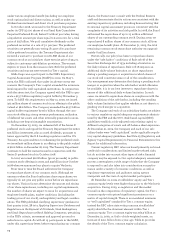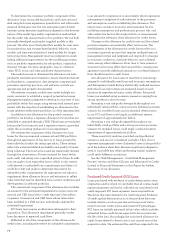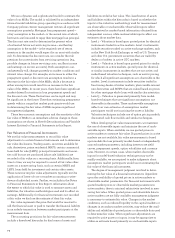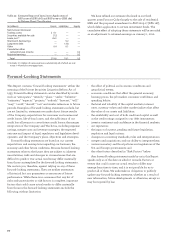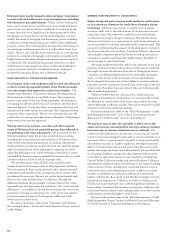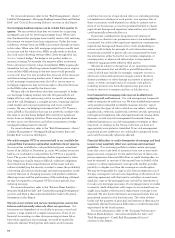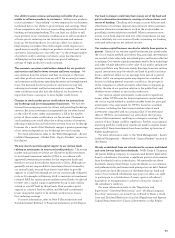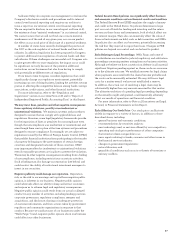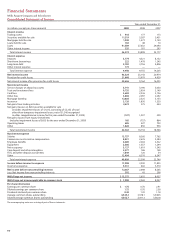Wells Fargo 2009 Annual Report Download - page 83
Download and view the complete annual report
Please find page 83 of the 2009 Wells Fargo annual report below. You can navigate through the pages in the report by either clicking on the pages listed below, or by using the keyword search tool below to find specific information within the annual report.
An investment in the Company involves risk, including
the possibility that the value of the investment could fall
substantially and that dividends or other distributions on the
investment could be reduced or eliminated. We discuss below
and elsewhere in this Report, as well as in other documents we
file with the SEC, risk factors that could adversely affect our
financial results and condition and the value of, and return on,
an investment in the Company. We refer you to the Financial
Review section and Financial Statements (and related Notes)
in this Report for more information about credit, interest
rate, market and litigation risks and to the “Regulation and
Supervision” section of our 2009 Form 10-K for more
information about legislative and regulatory risks. Any factor
described below or elsewhere in this Report or in our 2009
Form 10-K could by itself, or together with other factors,
adversely affect our financial results and condition. Refer to
our quarterly reports on Form 10-Q filed with the SEC in 2010
for material changes to the discussion of risk factors. There
are factors not discussed below or elsewhere in this Report
that could adversely affect our financial results and condition.
RISKS RELATING TO CURRENT ECONOMIC AND MARKET CONDITIONS
Our financial results and condition may be adversely affected
if home prices continue to fall or unemployment continues to
increase. Significant declines in home prices over the last two
years and recent increases in unemployment have resulted in
higher loan charge-offs and increases in our allowance for credit
losses and related provision expense. The economic environment
and related conditions will directly affect credit performance.
For example, if home prices continue to fall or unemployment
continues to rise we would expect to incur higher than normal
charge-offs and provision expense from increases in our allowance
for credit losses. These conditions may adversely affect not only
consumer loan performance but also commercial and CRE loans,
especially those business borrowers that rely on the health of
industries or properties that may experience deteriorating
economic conditions.
Current financial and credit market conditions may persist or
worsen, making it more difficult to access capital markets on
favorable terms. Financial and credit markets may continue to
experience unprecedented disruption and volatility. These condi-
tions may continue or even worsen, affecting our ability to access
capital markets on favorable terms. We may raise additional capital
through the issuance of common stock, which could dilute existing
stockholders, or further reduce or even eliminate our common stock
dividend to preserve capital or in order to raise additional capital.
Bank regulators may require higher capital levels, limiting our
ability to pay common stock dividends or repurchase our common
stock. On December 23, 2009, we repaid the U.S. Treasury’s
investment in us under the TARP CPP program. While we are no
longer a participant in the TARP CPP program, federal banking
regulators continue to monitor the capital position of banks and
bank holding companies. Although not currently anticipated, our
regulators may require us to raise additional capital or otherwise
restrict how we utilize our capital, including common stock
dividends and stock repurchases. Issuing additional common
stock may dilute existing stockholders.
In addition, the U.S. Treasury continues to hold a warrant to
purchase approximately 110.3 million shares of our common
stock at $34.01 per share. If the warrant is exercised, the
ownership of existing stockholders may be diluted.
Compensation restrictions could adversely affect our ability to
recruit and retain key employees. Following repayment of the
U.S. Treasury’s TARP CPP investment in December 2009, we are
no longer subject to the compensation restrictions applicable to
participants in the TARP CPP program. However, legislators and
regulators may impose compensation restrictions on financial
institutions, which could adversely affect our ability to compete
for executive talent.
We may be required to repurchase mortgage loans or reimburse
investors as a result of breaches in contractual representations
and warranties. We sell mortgage loans to various parties,
including GSEs, under contractual provisions that include
various representations and warranties which typically cover
ownership of the loan, compliance with loan criteria set forth in
the applicable agreement, validity of the lien securing the loan,
absence of delinquent taxes or liens against the property
securing the loan, and similar matters. We may be required to
repurchase the mortgage loans with identified defects, indemnify
the investor or insurer, or reimburse the investor for credit loss
incurred on the loan (collectively, “repurchase obligations”) in
the event of a material breach of such contractual representations
or warranties. In addition, we may negotiate global settlements in
order to resolve repurchase obligations in lieu of repurchasing
loans. If economic conditions and the housing market do not
recover or future investor repurchase demand and our success at
appealing repurchase requests differ from past experience, we
could continue to have increased repurchase obligations and
increased loss severity on repurchases, requiring material addi-
tions to the repurchase reserve.
For more information, refer to the “Risk Management – Reserve
for Mortgage Loan Repurchase Losses” section in this Report.
Legislative and regulatory proposals may restrict or limit our
ability to engage in our current businesses or in businesses that
we desire to enter into. Many legislative and regulatory proposals
directed at the financial services industry are being proposed or
are pending in the U.S. Congress to address perceived weaknesses
in the financial system and regulatory oversight thereof that may
have contributed to the financial disruption over the last two
years and to provide additional protection for consumers and
investors. These proposals, if adopted, may restrict our ability to
compete in our current businesses or restrict our ability to enter
into new businesses that we otherwise may desire to enter into.
In addition, the proposals may limit our revenues in businesses,
impose fees or taxes on us, restrict compensation we may pay to
key employees, restrict acquisition opportunities, and/or intensify
the regulatory supervision of us and the financial services industry.
These proposals, if adopted, may have a material adverse effect
on our business operations, income, and/or competitive position.
Risk Factors



